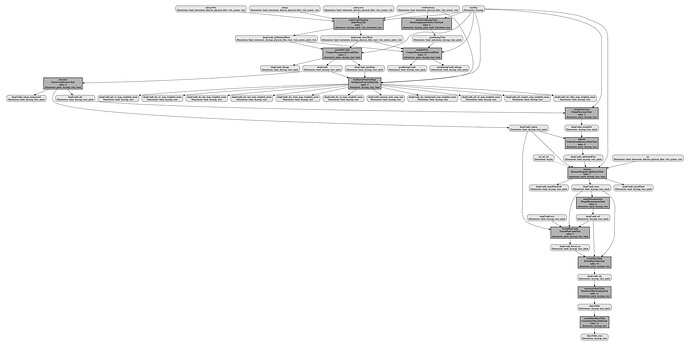Hi everyone! I have a question about which co-adds are the ones that the LSST runs photometry on by default. I found that for both object and source tables are the “astrometric and photometric measurements for objects detected in coadded images” on the DP0.2 data products page, but I’m wondering if anyone knows if these coadded images are refering to the deepCoadd or deepCoadd_calexp images? If not deepCoadd_calexp (which sounds like it has an extra little background subtracted post-coadd), does anyone know what we use the deepCoadd_calexp images for? Thank you!
I tried looking into this. I started at pipelines.lsst.io and searched for “deepCoadd_calexp”. One of the results was the page for the ForcedPhotCoaddTask, which lists the input as “A Coadd_calexp variant (e.g. deepCoadd_calexp )”.
ForcedPhotCoaddTask is one of the final stages of source measurement than runs before the Object table is written out (which I know from looking at the $DRP_PIPE_DIR/ingredients/LSSTCam-imSim/DRP.yaml file, which I knew to look at from tutorial notebook 09a).
This suggests the answer is deepCoadd_calexp.
Then the follow-up question might be, well, doesn’t this might mean that only forced photometry is from the deepCoadd_calexp? But, for the Object catalog, all the measurements can be considered forced photometry; the measurements are being made in all filters at the locations of all detected and deblended objects.
But I’m still not sure if (1) the above is correct and (2) if there is a better way to find the answer to your question…
I’ve attached a QuantumGraph for a recent DECam processing run I did with LSST pipelines
v23_0_1 (really the credit for this QuantumGraph should go to @sfu). I am not sure whether the DP0.2 runs would be the same in terms of QuantumGraph as are obs_decam coadd-level processings. But to me there does appear to be an answer based on this QuantumGraph: deepCoadd is used only for the coadd-level detection step, then subsequent coadd-level measurements (deblend, measure, forcedPhotCoadd) are done based on the deepCoadd_calexp products.
I’m just confirming other responses at this point, but yes, the short answer is deepCoadd_calexp: this is produced when running detection on the coadds, and it differs from deepCoadd only in having an extra round of background subtraction applied and the mask plane showing above-threshold detected pixels in each band. We then use deepCoadd_calexp for all subsequent processing, including the unforced and forced measurements on coadds.
Thanks all, this has been very useful.
I’ve generated something that should at least be closer to the DP0.2 coadd-level processing QuantumGraph than the DECam QuantumGraph that I posted earlier in this topic. I had to make a number of edits to $DRP_PIPE_DIR/ingredients/LSSTCam-imSim/DRP.yaml in order for the QuantumGraph to be generated successfully, but I don’t think any of these edits should affect the structure of the resultant graph in a way that’s relevant to this question. For instance, I had to comment out a handful of the specific faro metrics listed in YAML pipeline definition.
The QuantumGraph is shown below:
The command that I used to generate this visualization was:
pipetask build \
-p $DRP_PIPE_DIR/ingredients/LSSTCam-imSim/DRP.yaml#step3 \
--pipeline-dot tmp/pipeline.dot; \
dot tmp/pipeline.dot -Tpdf > imsim.pdf
This was run with LSST pipelines v23_0_1. I’ve attached my edited version of DRP.yaml that I used, and also the original version of that file from simply cloning the drp_pipe repo (named DRP-orig.yaml). Running diff on these two files would show the specific edits I made.
DRP.yaml (10.1 KB)
DRP-orig.yaml (9.5 KB)

